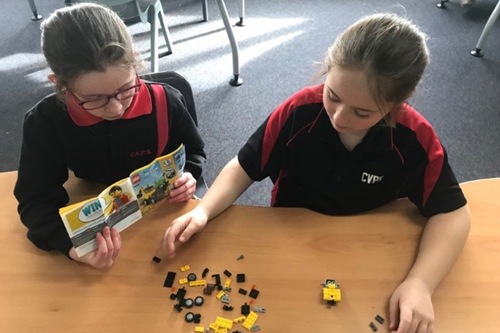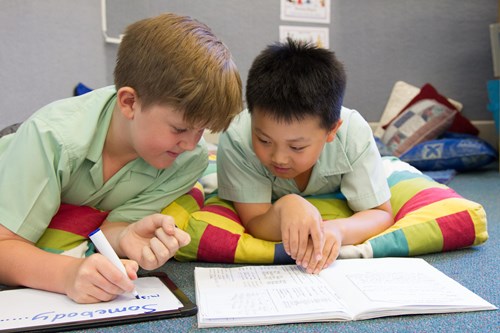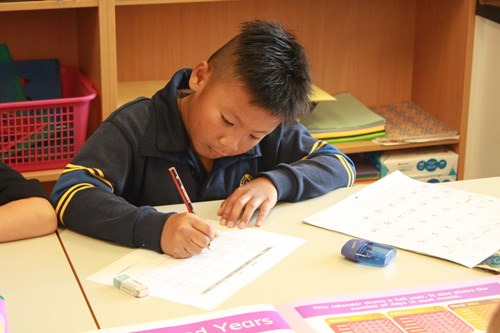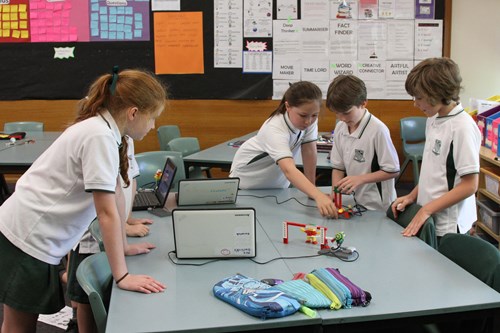When students share their artworks through performance, presentation or display, they are communicating imagined and conceptual ideas, emotions, observations, understandings and perspectives with their audiences. Presenting and performing work is an essential part of arts making that allows students to say to their audience, “Here is my work, it expresses my ideas”. It also provides a catalyst for interactions between the artist/performer and the audience as each responds to the work.

Exploring ways to engage in performance as an audience member
The Arts enables students to explore different aspects of arts practice. Students consider the art works they make from a range of viewpoints, including that of the audience. Making decisions about how their work will be presented allows students to communicate their thinking and share not just their work, but also their intentions as artists.
Ensuring that students have opportunities to make decisions about how an audience will engage with their work is one way that teachers can foster students’ awareness of themselves as an artist. Promoting student agency in this way also builds confidence and aesthetic awareness.
For example, students might consider:
- Where could my work be presented, performed or displayed?
- Who will be in the audience and what will I want the audience to know about my work before or as they see it?
- Will I introduce my work? How could I do that? Should I speak, write or record an audio or video introduction? How can I share with the audience my thinking about the ideas in my work or the observations and imaginings that inspired me?
- How many ways are there for me to share my work with the audience? Could the audience also view snapshots from my improvisations, trialling or exploration work or can I share information about the challenges of making the work or my reflections about the work?
- Where will my work be shown? Will the audience be guided through a display space or will they choose their own pathway?
- What do I want to tell the audience about me as an artist?
- How will the performers let audience know that the performance is about to begin or when it has ended?
- How can I seek feedback from the audience? What questions could be included in a survey or what would I ask audience members if I spoke to them?
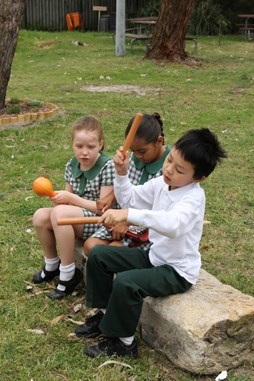
Collaborating and exploring how performance will be presented, performed and displayed to the audience
The works that students present, perform or display to demonstrate their arts learning might feature a single arts subject, combinations of arts subjects or connections between The Arts and other learning areas. The school stories in this article highlight how performance can be used to structure learning that connects The Arts with other learning areas and the General capabilities.
Preparing work for presentation, performance or display might also involve students developing their skills in collaboration, communication, literacy, numeracy or ICT by:
- inviting peers, family or members of the community to join the audience
- designing, sourcing or making items to enhance their performance, presentation or display
- developing a marketing campaign or writing promotional material to attract an audience for their work
- seeking permission to use images, audio or video material or obtaining permission to perform a scripted work.
The elaborations for the sub-stand ‘Sharing artworks through performance, presentation or display’ in Australian Curriculum: The Arts include further ideas for presenting, performing or displaying work.
Performing is one of three main practices underpinning the Dance curriculum that involves practising, rehearsing, refining and applying physical and expressive techniques to communicate a choreographer’s ideas.
Across F–6, students present and perform dances they have created, dances from cultural groups in the community and dances that tell cultural or community stories. Students might also share their thinking by displaying images they used as an inspiration, video snapshots showing how they used improvisation to develop movements, or by sharing audio where they talk about a dance tradition or the development of their dance.
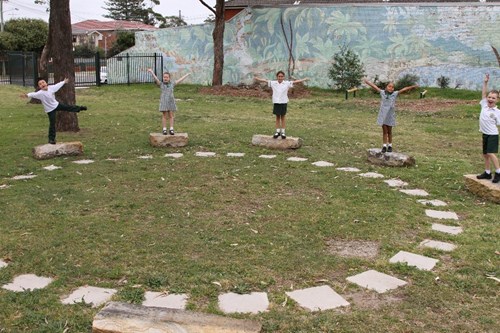
Statues, ready to perform
Content descriptions

Optional content elaborations
Foundation to Year 2:
- expressing ideas to an audience through movement, for example, showing contrasting dynamics by stamping heavily and tiptoeing lightly, or using movement qualities such as slow controlled sinking to the floor to express melting ice and sharp jerky movement to express a robot
Years 3 and 4:
- using expressive skills of projection and focus to communicate dance ideas to an audience (school assembly, community festival, etc.); for example, looking out and up to the ceiling and extending movements outwards to express a feeling of joy
Years 5 and 6
- presenting their performances using internet-based technologies, including social media.
School story: Creating dance through school and arts organisation partnerships
Moving East 1 project
Moving East 1 project: DRILL and South Arm Primary, Clarendon Vale Primary, Rokeby Primary and Bayview Secondary College, Tasmania
For the Moving East project, Hobart’s youth dance company DRILL worked with a group of primary schools and students from a 7-12 school to create and present a dance work in response to Dust by Dancenorth, which toured to Hobart for the Ten Days on the Island festival. Dust featured designs by Hobart-based designer and architect Peta Heffernan (Liminal Studio). Students explored some of the core inquiries of Dust, including things in their lives that they inherit and how they choose to deal with them. Students co-created movement that reflected their responses to these inquiries with DRILL choreographer Felicity Bott. They also made sets using recycled boxes inspired by Peta Heffernan’s designs for Dust and designed t-shirts that represent the different structures made with the boxes throughout the work. The performance took place on a Saturday afternoon at the Clarence Plains Harvest Festival and attracted a large audience with some families attending a school event for the first time.
Dance Nexus 2019 project
Dance Nexus 2019 project: DRILL and Windermere Primary, Moonah Primary, Glenorchy Primary, Kempton Primary & Montrose Bay High, Tasmania
Each school that participated in Dance Nexus 2019 worked with a professional scientist who spent time sharing their work and research with the students and gave them a glimpse into their life as a scientist. Students then worked with choreographer Felicity Bott to create dance pieces about their scientist. The scientists were amazed at the different ways students incorporated their science knowledge and understanding into dance, and easily recognised aspects of their work that they’d discussed with the students.
Jane Polley, Curriculum Leader of The Arts at the Department of Education, Tasmania, has shared this description of the value of these projects for the students, teachers, schools and wider education community:
The Tasmanian Department of Education’s 2018–2021 Strategic Plan is ‘committed to inspire and support all learners to succeed as connected, resilient, creative and curious thinkers’.
Projects such as Dance Nexus and Moving East provide opportunities for learners to:
- connect with a diversity of teachers, industry professionals and learners from other schools in a co-creative way
- develop resilience through an artistic process that includes rehearsals and performances
- create original artwork in response to interdisciplinary cross-curriculum themes
- investigate not only the possibilities of dance in themselves as makers and performers but grapple with challenging choreographic concepts.
It was obvious that the young people were engaged and were developing confidence and performance skills that could be transferable to other areas of their lives. It was also an opportunity for the whole school and parent community to come together and celebrate the achievements of their young learners. Opportunities that combine the talents and pedagogical groundwork of teachers with the professional artistry of industry creatives result in new and innovative educational practice.
Feedback from the school leaders and teachers involved with these projects echoes Jane’s comments. For many of these students, this program was the focus of their arts learning for the year. Highlights for the teachers included:
- rich opportunities for students to work with arts professionals and with Hobart-based scientists
- the ways the projects connected learning across the curriculum and developed students’ imagination, curiosity, critical thinking and confidence
- positive responses from families and community members.
In Drama, students can informally present work they improvise or devise through dramatic story-telling or purposeful play. Showing or presenting allows students to trial ways of expressing ideas and feelings, experience being ‘in role’, view different perspectives and responses to the same stimulus or provocation and to receive feedback. As they reflect on their own drama or view the drama created by their peers, students can make personal responses and build their capacity to feel and manage empathy. Across F–6, students might also present performances of work they have devised or perform scripted work to broader audiences such as peers, their families or the wider school community. For these presentations, enabling students to choose and design props, costumes or set pieces could foster student agency, engagement and a range of general capability skills.
Content descriptions

Optional content elaborations
Foundation to Year 2
- following cues and using voice and movement to link action, ideas and stories in their drama
- considering viewpoints – meanings and interpretations – for example, What do you want your audience to think about your drama? What did this drama make you think about? How did you feel when making/watching the drama? Evaluations: What did you like best in the drama? Why?
Years 3 and 4
- applying story structures in their drama, including roles and events linked through cause and effect and dramatic tension
- performing their improvised sections of process drama and play building
- sharing with others dramatic action that is structured through dramatic tension, in real or virtual spaces
- Considering viewpoints – evaluations: For example – How well did you collaborate to make drama? What worked best in the drama?
5–6
- creating narrative and tension to communicate dramatic meaning
- Considering viewpoints – meanings and interpretations, for example:
- What did the performer intend audiences to experience and understand from the drama?
- Why did you make this drama?
- exploring and applying different performance styles, and drawing on drama from other locations, cultures and times as sources of ideas in their own drama, and considering any protocols for representing community or cultural stories in performance.
School story: Connecting Drama and literacy at St Flannan’s Catholic Primary School, Brisbane
Denise Davy, Drama teacher at St Flannan’s Catholic Primary School in Brisbane, outlines how students express themselves and how they are learning in Drama in Years 2, 5 and 6.
To facilitate student discussions, I ensure that there are both formal and informal experiences for sharing, whereby students are both active participants and audience members, which sometimes happens concurrently. Sharing varies from spontaneous improvisation to rehearsed work. Sometimes it is individual or in pairs, whilst other times it is larger groups requiring greater collaboration and planning.
Some performances are displayed within a safe circle, while other drama demands the use of the stage with a more formal audience. Students also experience additional rehearsals and refinement for some sections of their work in preparation for formal assessment.
Our lessons begin in a drama circle. Each week a student assists me with peer assessment and feedback using the success criteria given. They are encouraged to use sentence starters like ‘I really enjoyed…’ and ‘Even better if…’. This ‘drama critic’ role has become highly sought after and the students love the opportunity to share their opinion and provide feedback in a safe and encouraging environment. Our drama lessons end with approximately 20 minutes of dedicated formal performance and sharing time. We are always working on respectful audience manners and practising the art of truthful words phrased in a positive and encouraging way.
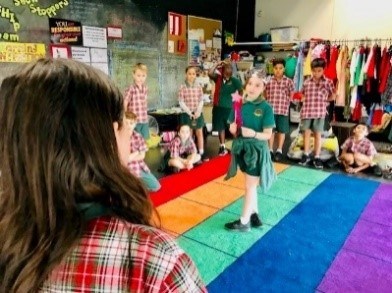
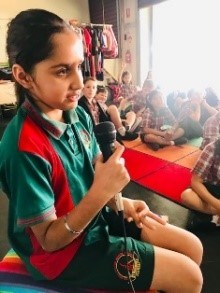
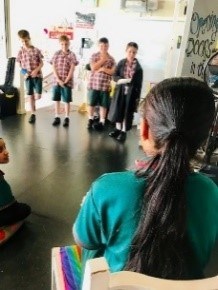
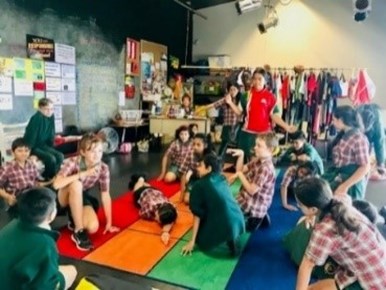
Examples of the drama critic leading the drama circle work and also doing critic work following a performance
Connecting drama and literacy in Year 6
From reading and exploring the text ‘Grimsdon’ by Deborah Abela, the students had a significant background in the setting, characters and the story. This activity used a drama device ‘3D body mapping’. In this activity, the students were both active participants and audience.
The students were given multiple opportunities to share their ideas and understanding through a range of drama activities such as:
| GOSSIP MILL | In concentric circles, the students took on the role of a (generic / not main role) villager. The children spoke in role considering their status and voice in particular. They moved seamlessly into the next ‘Setting’ activity by putting on music and asking the children to spread out in the city, going about their daily business. |
| TAP IN | (senses): I can hear… / I can see… / I feel / I can touch / I can smell |
| SCULPTING | Courage vs fear, hope vs hopelessness |
| READERS’ THEATRE | In groups they worked with a simple script. Fifteen minutes of rehearsal and then each group performed for the rest of the class. |
| A BLEND OF HOT SEATING AND MANTLE OF THE EXPERT | I made simple props and costumes available. We called a town meeting and the whole class engaged in a role play where they were able to ask the protagonists what qualities they had that could lead the people out of the disastrous situation they found themselves in. |
| DREAM SEQUENCE | Using music as a relaxing stimulus, the students rested on the floor using cushions provided. I read an excerpt on Isabella’s recurring dream. Half the class became Isabella’s dad who appears to her in a dream with a message. The other half were Isabella dreaming. We then swapped roles. |
To find out more about these drama activities, see resources that focus on Process Drama such as:
- Brentnall, R, Process Drama: A sure way to ignite student learning, in Australia Drama Education Magazine, No. 14, 2018 (e-pub, https://dramaaustralia.org.au/wp-content/uploads/ADEM-No14-2018.pdf, accessed 2 October, 2019
- Ewing, R and Saunders, JN, The School Drama Book, Currency Press, 2016. Hardcopy and e-book available
- Saraniero, P, Process Drama: Taking a Walk in Someone Else’s Shoes, https://artsedge.kennedy-center.org/educators/how-to/from-theory-to-practice/process-drama.aspx, accessed 2 October, 2019
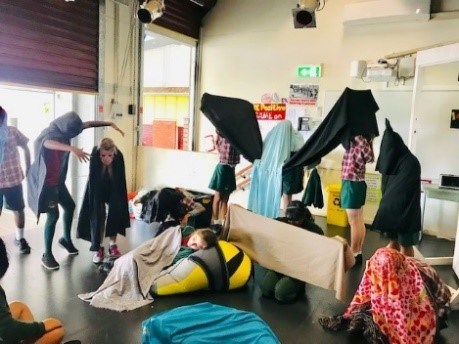
Students in a freeze frame
The excerpt below was used as a stimulus for Freeze Frames in groups of six–eight students. A freeze frame is a drama device that encourages students to ‘zoom in’ on a moment in the story and to embody the action. In this case I allowed some students to create inanimate objects too. With student volunteers, I modelled a freeze frame highlighting the importance of varying levels. Students were encouraged to use coloured fabrics in the final stages of their planning and presentations. After 20 minutes of rehearsal, the groups then performed their freeze frames on the stage to the rest of the class. We used TAP and TALK* to discover more about the freeze frames.
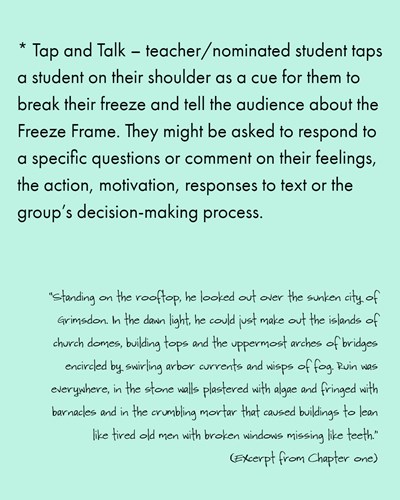
Connecting drama and literacy in Year 5
‘One Small Island’ is set on Macquarie Island, a world heritage site deep in the Southern Ocean that Sir Douglas Mawson called ‘a wonder of the world’. During our literacy block, Year 5 students explored the story ‘One Small Island’ by Alison Lester and learnt about 19th century sea travel. Exploring the story through drama began by looking at photos and video of re-enactments showing the roles, responsibilities and status of crew members on a sailing ship captained by Thaddeus von Bellingshausen. Using ‘teacher-in-role’, the students participated in a whole class role play. They created and shared scenes to represent onboard life including sound effects to create the atmosphere.

Students in role as crew members on a sailing ship
Connecting drama and literacy in Year 2
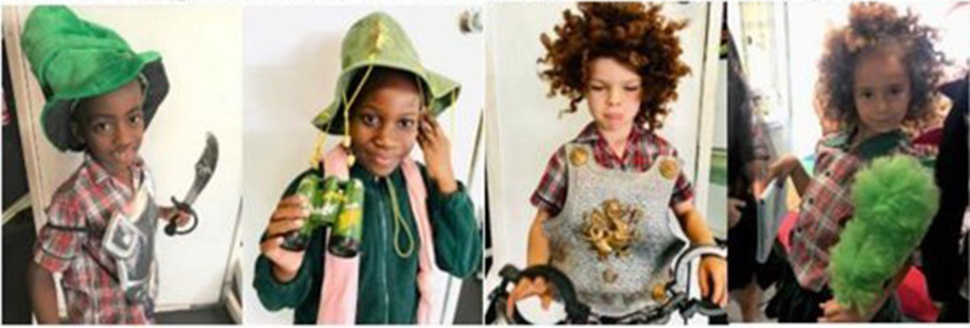
Year 2 students dressed for a crazy dinner party
The Year 2 students explored ‘Marge in Charge’ by Isla Fisher in their literacy block. It’s a story about rules, roles and responsibility. In Drama, the students mirrored a scene in the book where Marge, the babysitter, allows the two children in her care to dress up for dinner. Our students used costumes and props to design themselves a suitable outfit for a crazy dinner. In turns, we showcased their designs on a fake catwalk allowing them to demonstrate drama skills relating to character, voice and movement, much to the delight of the other students.
In Media Arts, students create and analyse forms such as film, news report, documentary, advertisement, music video, animation, video games and/or a combination of these. They think about the potential audience as they plan, produce and distribute (share) their media artwork. They seek and analyse audience responses during the making process and when the work is complete.
Content descriptions

Optional content elaborations
Foundation to Year 2:
- capturing and sequencing images and text to create comic books that retell familiar and traditional stories to share with the class
- collecting and sharing, with permission of the people involved, class stories and presenting them in the form of a class news bulletin
- producing and presenting a media artwork for a particular purpose; for example, creating an advertisement that recommends appropriate behaviour when using cameras in the room
Years 3 and 4
- storyboarding and filming a short sequence showing a conflict, selecting camera angles, lighting and costume to convey meaning without dialogue
- planning and scripting a radio advertisement for a school event with respect for the rules and image the school seeks to promote
- seeking permission to take photos of class members, to document a school excursion, for publication on the school intranet
Years 5 and 6
- designing a storyboard that reflects a key scene in a sequence; for example, an opening scene of a film that shows the important camera angles, transitions, edits, voice and soundtrack
- designing a navigational plan for a game, using multiple levels and obstacles; for example, creating and designing problems to be solved in order to progress to a new level
- presenting their media artworks using internet-based technologies, including social media.
School story: Film and game making at Doreen Primary School, Victoria
Specialist teacher Dianne Zobel describes how Doreen Primary School used the Media Arts curriculum to integrate learning, involve students from Years 3–6 and work alongside specialists and community members:
Each year, Doreen Primary School participates in the ACMI Screen It Competition, a national competition for student filmmakers, animators and game developers. This year, the students prepared two ambitious projects: a film called Wear It and a game still to be named.
Wear It is a documentary made from a combination of live footage, animation and interviews. We started thinking about the problem of plastic waste. We interviewed Mrs Fraser (a retired teacher from the school) and listened to her story about school in her day, pre-plastic. We invited Alex from Colourful Collective – a social enterprise that recycles plastic waste) to show us how to make waste into treasure. Then we had an idea for our film: Plastic Alchemy. It’s about listening to those who came before us, but also about doing something positive: We turn plastic into cool clothes. We wove the story of plastic waste with how we could do something creative as a contrast to Mrs Fraser’s conversation and we called it ‘alchemy’. One student’s father came in to do a voice-over for our film explaining his Indigenous heritage and the absence of waste in his culture.
The learning process for Year 6 students involved in Wear It consisted of several components:
- The history of our locality: what school was like before plastic became popular. In the film, our narration begins with a retired teacher who used to work at our school.
- Inquiring into how Indigenous people lived without creating waste. The students talked to a parent about how his ancestors lived and what he was taught as a child about caring for country, the environment and waste.
- Recycling: how to creatively think of solutions for the plastic waste problem that we now face. The class discussed the issues around plastic waste and worked with a guest who is actively involved creatively thinking about the problem and some solutions. She helped us to make plastic waste into clothes.
- Film, editing and animation: students took responsibility for the making of the film and developed their skills in using the technology.
- Sound: students researched and selected sound to accompany the film.
- The importance of getting the right message across to an audience: students talked about the messages they wanted to communicate throughout the project. This happened through class discussions and as part of the conversation.
Showing our film to different audiences before editing was an important step. We showed the film to audiences of very young students, senior students and adults. Each time it instigated lively conversation, which gave us confidence that the film was communicating our messages was being received clearly. The young audience was captivated by the magic of making the clothes and the story. The older students were interested in the history of our school and to realise the short time it has taken to generate such a huge amount of plastic waste. The solution to the problem offered in our film created a positive feeling of action and purpose. When adults watched the film, they immediately started reminiscing about their school days and about their memories of life before and after plastic.
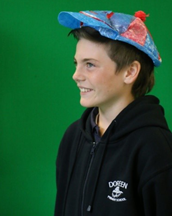
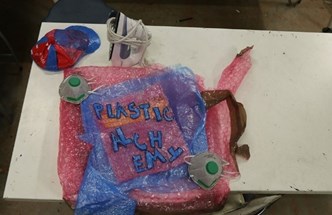
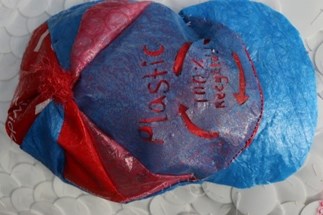
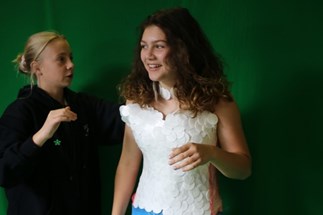
Generating creative solutions for the plastic waste problem: making plastic waste into clothes
Connecting to the integrated topic for the year:
The theme for Wear It was adapted from our integrated curriculum topic this year: the world/environment. The students’ enthusiasm for the project was the deciding factor when we selected the topic. The approach to learning involved collaboration between classroom teachers and specialists. Students completed aspects of the project during art class time or were withdrawn from class during the making process, such as filming, animating and editing. Each group worked on a small piece and within that segment individual ideas were developed.
Involving other year levels:
All students from Years 3–6 were involved in this project at some level. Year 6 students made the clothes, produced the live film and created the animations. Other year levels were relied upon to review, discuss and make suggestions. Our visitors’ contributions stimulated discussion and enriched the project for the whole school community. As well as teaching technology, history and environmental issues, the project extended students and introduced possibilities to further learning and career pathways. Students in Year 3 were asked to review the film during the making/production process. They wrote ideas for improving the story, strengthening the message, looking for spelling mistakes or finding glitches to repair. Design and artwork were selected from the Year 6 students’ visual arts sketchbooks. All students in Years 3–6 thought about the concept and recorded their ideas in their visual art diaries. Students in other levels also designed clothes to be made from recycled plastic.
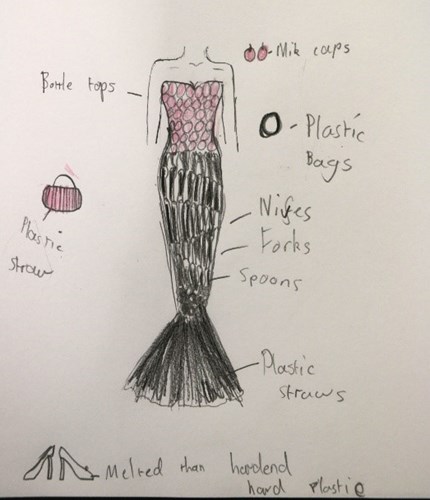
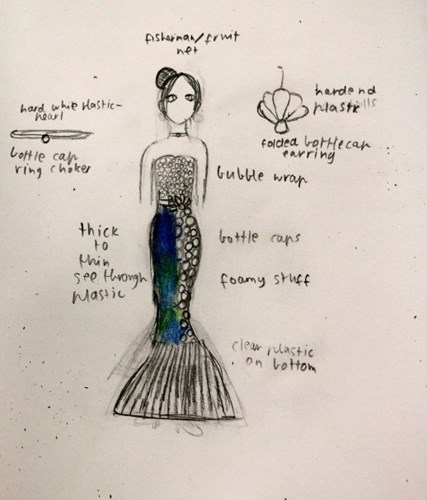
Generating creative solutions for the plastic waste problem: designing costumes out of plastic waste
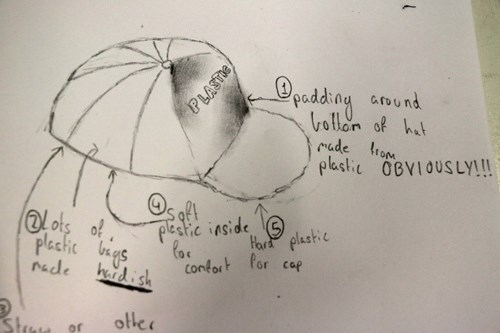
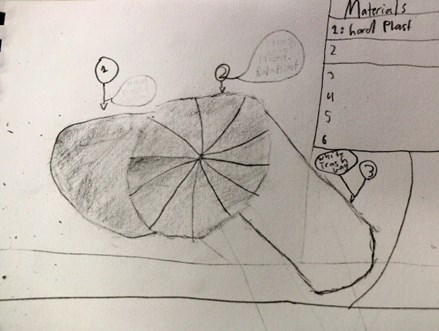
You can view Wear It here.
Student reflections and sharing about the Wear It project:
Allanah:
Doreen Primary School has made a live action documentary called Wear it. Wear it is about people reusing plastic and turning it into treasure. We had a retired teacher from Doreen tell us about her day and how she started to see plastic come into fashion. We also had a father from Doreen, who is Aboriginal, tell us about the ancestors’ way of life without waste. We also had a lady named Alex from Colourful Collectives who helped us make plastic into clothes.
One day, two people cleaning up rubbish on the beach, found a shell and put the shell up to their ears and listened to an Indigenous man. He talked about his life before plastic. Wear It is to inspire other people to do something creative about waste, like reuse plastic so we do not destroy the earth and save the turtles. The things that I did to participate in the making of our movie Wear It was the making of the clothes, I worked with Lily to make the top for the mermaid outfit that Harlee wore. Then I edited many scenes and my voice was recorded but never got put in, that is because it is very hard to get everyone’s voice in when we have a whole grade to work with.
Student, Lily, recorded her reflections and can be viewed here.
The school’s second entry for ACMI Screen It Competition, was a game designed and made by Mr Miller’s Year 5 students. The student comments below capture student reflections about about the Year 5 Game:
Danisha:
The game is a maze. In the maze, there is a bad cranky monster called Frankie Fermata. Frankie has minions, and those minions will have names! And for lucky last but not least, the only good character is Sunny. He’s called Sunny because he is a sun. Now let’s get to the point. Frankie Fermata is quietly sitting trying to sleep and can’t hear a sound. But all of a sudden, Sunny walks in with lots of sound. All the notes wanted to stop hiding but they were frightened of Frankie Fermata. So, the notes cried and cried making sounds. Every time Sunny stops walking, he tries to hear the notes and collect all of them. All the notes make a different sound. While Sunny is trying to get notes, Frankie is trying to get him. Someone in our class named Oscar had the idea of the maze, without him we would have taken a long time. Then there’s me (Danisha), Toby and Dave who created the chosen characters.
Well, getting the game step by step we had to do a lot of voting and talking. It was hard, honestly.
Ethan:
Our game is related to the theme Listen. We move around a maze trying to find notes that are hidden. The notes sing to themselves. As you try to find the notes, you’re being attacked by mini-munchers. Their leader, Frankie Fermata, sent them to make sure no-one gets the notes. If the mini-muncher touches you, you return to the start. The class came together and brainstormed different ideas related to the theme Listen.
We had to
- decide on characters
- decide on the style of game
- learn to code
- create designs
- make game
- make script
- decide on voices
We communicated with each other and learnt new things each day. The message we are communicating is: Listen out to the notes, save them from evil Frankie Fermata and his mini-munchers. It was a class effort and it all went smoothly.
Georgia:
Our game is about listening. You have to make it to the end of each level and collect music notes. Make sure you don’t run in to Frankie Fermata. And don’t run in to mini-munchers or they will eat your music notes and maybe you. The ideas came from everywhere. Parents, students, teachers, pets and many more people. I love our game. We had very different ideas. Some were animals throwing things like bananas, avocados and other food. Another idea was that you were in a car and you had to swipe items that were in your way the car horn would beep faster as you got close to an object. If there was a kid in front of you, you would swipe him/her out of the way, then stop and talk to them about road safety.
We voted and thought the maze idea was better.
Through performance, musicians communicate ideas, emotions and creativity with audiences. The performance sub-strand of the Australian Curriculum: The Arts: Music focuses on developing students’ ability to make decisions about the music they have chosen to perform and the nature of their performances. It also focuses on creating music through improvisation or composition.
Planning music performances involves decision-making about how the music will sound and how it will be presented. These decisions involve both making and responding and content from each of the sub-strands can also be involved. For example, when students improvise and perform, they use listening (aural) skills to shape the sound of each note.
Content descriptions

Optional content elaborations
Foundation to Year 2:
- Choosing and combining sounds to create compositions, for example, combining pitch and rhythm patterns
- Improvising with voices and sound sources to express actions, thoughts and feelings
Years 3 and 4
- Experimenting with ways of using voices and instruments, combining sounds, silence, tempo and volume to create and perform music
- Improvising and trialling ideas to create compositions for specific audiences and purposes
Years 5 and 6
- Improvising and experimenting with combinations of sounds and technologies to create moods and atmospheres
- Exploring rhythm, pitch and dynamics and expression to create contrast repetition and balance to develop compositions for performance
- Presenting performances using internet-based technologies including social media
Depending on the music learning opportunities available to them, F–6 students might also:
- choose and learn pieces for performance in informal settings such as their classroom or other students at their school
- present a performance of music they have improvised or composed, or they might interpret and perform music created by other composers
- create, perform and record music for a Media Arts, Dance, Drama or multi-arts work they or other students are creating or create and perform a sonic component for a Visual Arts installation
- perform as a member of a group, choir or ensemble at a school, festival or community event.
Giving students opportunities to plan and present or co-curate a performance is one way of connecting learning across the four strands of the Australian Curriculum: The Arts: Music. In the school story below from Port Elliot Primary School in South Australia, the students worked towards two events. The first, a performance with a band that visited the school, involved structured listening and rehearsal activities led by the classroom music teacher. For the second performance at a local nursing home, students planned the performance based on pieces they were learning through an instrumental music program.
In each case, students began exploring the music they would be playing through listening. This allowed them to develop aural, instrumental and vocal skills, make decisions about how they would present their work to the audience. They were also encouraged to communicate their responses to music they heard and performed and to reflect on their performance. This approach gave students opportunities to investigate:
- how to engage the audience
- how elements of music can be interpreted by reflecting and making decisions about tempo
- the use of instruments and equipment
- where the performance will be presented
- how performers will enter and leave the performance space
- whether a performance should be presented live or through a recording.
Enabling students to be in control of the decision-making process relied on the students knowing their intentions for their performance and developing the skills to realise them effectively.
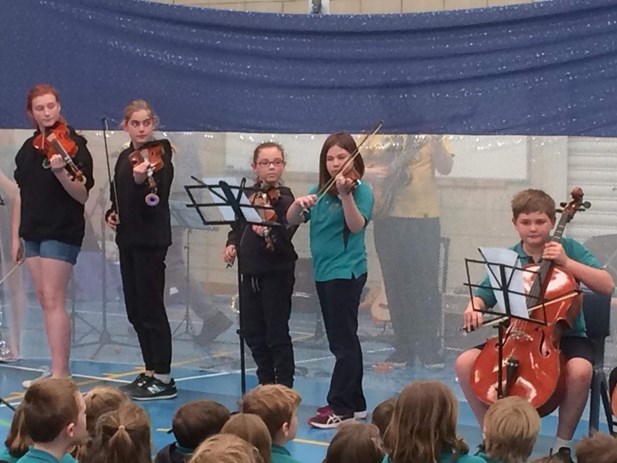
School story: Student narratives about preparing to perform with a band and at a local nursing home
Port Elliot Primary School, South Australia
Classroom music teacher, Natalie Bond, outlines how she planned learning activities in preparation for an incursion by the Music Is Fun band:
Prior to their visit, the ‘Music Is Fun’ band sent their repertoire along with a list of the songs and music tracks they would be performing. The intention for this was to enable students to engage in the live performance if they felt confident. As part of this process the students listened to two songs from the ‘Music is Fun’ list each week and watched video clips, which included the song (for example, ‘The Lion Sleeps Tonight’ from the movie Lion King, ‘Life Is a Highway’ from Cars). Students also learnt the chorus to sing along during the performance and discussed the origin of the songs in their original form. Researching song origins, listening to different versions and discussing histories of songs proved a fantastic way to make connections within music.
The students who chose to perform with the Music Is Fun band rehearsed with the band prior to the performance and felt supported to perform in front of the whole school.
Three students who participated in the Music Is Fun also presented a performance at a local nursing home and reflected on their experiences:
What music did you play for these performances?
Student 1: “I played the violin in the piece Million Dreams by Benj Pasek and Justin Paul. I played in the chorus and I liked it because it was a song I knew, the 2nd Chorus was hard.”
Student 2: “I played the cello and we played A Million Dreams.”
Student 3: “I played the violin and we played A Million Dreams with the Music Is Fun band that came to our school. For the nursing home, we played Kookaburra, Happy Dance, Folk Dance and a few other songs.”
What does your audience need to know about the pieces you play and the way the performance will happen?
Student 1: “When we performed for the nursing home, it was the first time we performed with another school and in front of people other than our school.”
Student 2: “It was a new song and we had to learn it in a week, so we only played the chorus. This was our decision as a group.”
Student 3: “We put a lot of effort onto practising and making sure we had it perfect.”
How did you prepare for these performances? What decisions did you need to make?
Student 1: “We decided as a group what songs we would play and when we would do it.”
Student 2: “For the nursing home performance, we sat like an orchestra with students from another school. For the Music Is Fun band performance, we stood facing the audience, and the cellos sat.”
In summary, music teacher Natalie Bond reflects:
Performance opportunities give students confidence and a sense of achievement. They receive immediate feedback through audience engagement and enjoyment and can then self-reflect on their personal performance. Performance is an important part of any arts program to share knowledge, extend skills and celebrate creativity. A successful arts program has the power to enthuse, empower, engage and excite.
In Visual Arts, both making and responding involve developing practical and critical understanding of how the artist uses an artwork to engage audiences and communicate meaning. Students can present and display their visual artworks in many informal and formal ways to reflect the ideas and intended meanings in their work. They might also share their responses to images or other stimulus material they used as inspiration, excerpts from a hard- or soft-copy visual journal to show how they have selected, manipulated or adapted materials and techniques or record oral commentary about their work or how their experience of other artists’ work has shaped their ways of representing and expressing ideas, observations and imagination.
Content descriptions

Optional content elaborations
Foundation to Year 2:
- sharing ideas with their classmates about the representational choices they made in their artwork
- talking about ideas such as themes when displaying artworks; for example, at the local gallery or in their classroom
- making a decision about how to display their artwork to share their ideas
Years 3 and 4
- making decisions about how their artwork could be displayed; for example, mounted and framed, in public spaces, on the internet and in the media
- exploring different ways of presenting artworks in different locations; for example, in folios, digitally, in a public space in the school
- comparing the visual conventions in artworks made for specific purposes; for example, how the artist represents an idea to show the audience a particular viewpoint
Years 5 and 6
- identifying reasons for the range of audience interpretations of the same artwork; for example, considering viewpoints or the conceptual approach of the artwork
- recognising and evaluating how culture, gender, age, time and place, among other factors, impact on how an audience reads an artwork; for example, comparing the response of different age groups
- reflecting critically on how effectively their ideas or feelings have been expressed in their own artworks, and that of others
School story: The ‘Stick It’ project
Korin Lesh, Arts teacher from Millner Primary School and President of Art Educators of the Northern Territory (AENT), explains the story of the ‘Stick It’ project.
The ‘Stick It’ project is an AENT initiative in its second iteration in 2019. Art Educators members are asked to upload a maximum of 10 images per school to share the breadth of their current art program. This year, 11 schools participated, and 114 student images were included from primary, middle and senior classrooms. The images were uploaded to the AENT website, where they could be collated and sent to be printed as stickers. At the Art Educators of the Northern Territory members exhibition, the stickers were displayed as 'Stick It' and made available for purchase by donation to help fund the printing production. The initiative has several layers. First and foremost, it is an opportunity for remote teachers to share the wonderful work they are doing in their classrooms. As it is difficult for many teachers to get into 'town' and participate in professional learning, we wanted to acknowledge the great visual art that is occurring across Northern Territory schools. Second, we wanted to create a real audience for students and package the artworks in a way that children would like. As stickers are an enduring incentive and fun medium for children, it was decided that the work would be printed as stickers. We also wanted to share the stickers alongside our own teacher artworks at our annual members' exhibition so that students could see that we are practising artist as teachers and practitioners in our area of expertise. Comments such as “Mrs Lesh is a great artist. That's why she teaches art at our school because she is so good at art” made by a student to his teacher and mother at the exhibition opening exemplifies the power of art teachers sharing their art and expertise in the community.
Student reflections
The comments below capture reflections from Jessie, a Year 6 student from Bradshaw Primary School in Alice Springs about her work and the Stick It project:
- Tell us about your artwork.
“My artwork is a Flower about warm and cool colours, which was inspired by the artist Georgia O’Keeffe.”
- What ideas do you want to share with people who see the stickie version of your work?
“I want them to know that it’s an artwork inspired by Georgia O’Keeffe and that it shows the warm and cool colours.”
- How did you make the work?
“I started my artwork using grey lead pencil, I draw my flower shape then went over all my lines with a black texta. I then coloured my flower using oil pastels. I used warm colours inside the flower and cool colours for the background.”
- How do you feel about your work being part of the Stickies project?
“I feel proud that my work was made into a sticker and that other people got to see my work.”
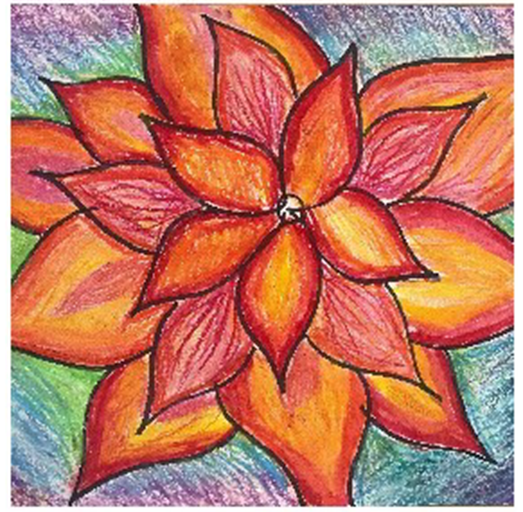
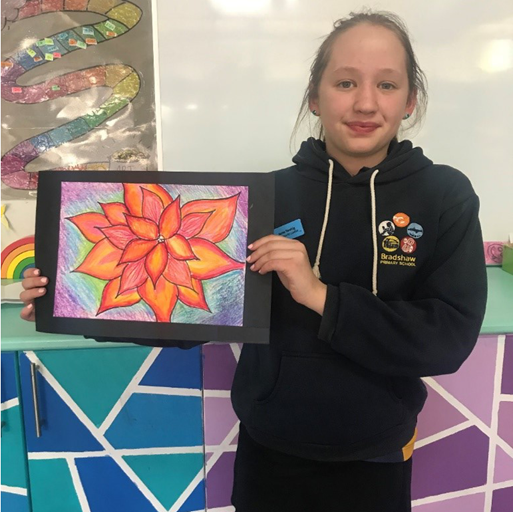
Year 6 student Jessie presenting her artwork
Teacher reflections
Jessie’s Visual Arts teacher, Lauren Wilson, captures her thoughts about the project below:
My students love seeing their work on display, and love sharing what they are learning and making in art with their classmates and families. Having the opportunity for student’s artwork to be turned into stickers and presented with a number of other schools at the opening of the festival of teaching in Darwin has given our students the chance to showcase their work to a wider audience. Our students can learn that their art is important not just to them but to others as well.
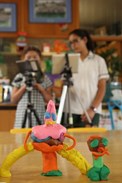 Welcome to the October issue of Primary Matters. In this edition, we unpack curriculum content in the ‘Sharing arts works through performance, presentation or display’ sub-strand of Australian Curriculum: The Arts and look at some examples of ways students are presenting their work.
Welcome to the October issue of Primary Matters. In this edition, we unpack curriculum content in the ‘Sharing arts works through performance, presentation or display’ sub-strand of Australian Curriculum: The Arts and look at some examples of ways students are presenting their work.